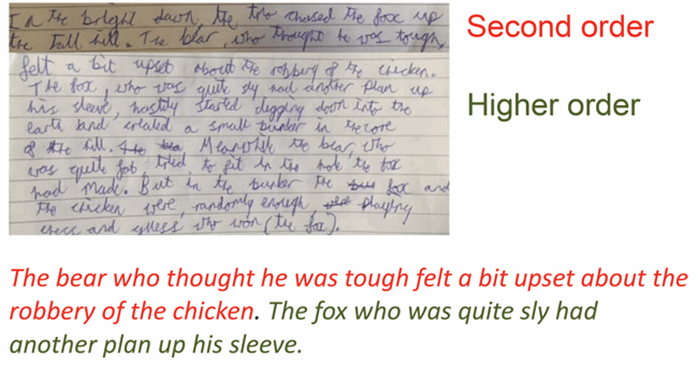Theory of mind relates to a person’s ability to understand the perspectives of others, to be aware that they may differ from one’s own perspectives and the ability to use this knowledge to navigate social situations. Dr Helen Chilton explores theory of mind and how its development can differ in children with a permanent hearing loss.
Background
Some of the challenges experienced by children with a permanent childhood hearing loss are not necessarily caused by the hearing loss itself but present as a preventable by-product. One of these challenges can be seen in the ability to understand the perspectives of others.
As inhabitants of the social world, we use our social cognition abilities to understand how other people think and feel and formulate appropriate responses. We often do this without conscious consideration and sometimes in situations where others are guarding their true thoughts or feelings. This type of perspective-taking is known as theory of mind (ToM).
Early ToM research was conducted with children with autistic spectrum disorder and the results demonstrated that they found it challenging to separate what they knew from others’ thoughts [1]. This early work relied on the use of a ‘false-belief’ task which could typically be passed by children between the ages of four and six years old. The false-belief task sought to understand whether a child could separate what they know from what another person knows. Various permutations of the task emerged in the literature, typically using dolls/puppets and hidden objects.
ToM and deafness
During the 1990s, research began to consider deaf children’s abilities to pass false-belief tasks [2]. Some of the findings from early work on false-belief indicated: (a) that potential for delay existed amongst deaf children of hearing parents who used spoken language and (b) less evident delay in the initial ToM skills in deaf children of deaf parents who were native sign-language users. Later work has demonstrated that cochlear implantation has supported deaf children’s abilities to pass false-belief tasks within age-appropriate timescales.
Figure 1. A summary of the developmental trajectory, adapted with permission from Westby & Robinson [3].
Age 4-5 years - First order skills:
-
Pass false-belief tasks
-
Attribute thoughts (cognitive) and feelings (affective) to others
-
Understand not only what people see but how it appears to them
-
Understand that we know information because we have seen or heard it
-
Understand that beliefs cause people to act in certain ways
-
Understand that thoughts/emotions are caused by what people think is the case even if it conflicts with reality
-
Can describe situations where they are happy, sad, mad, scared, surprised
Age 6-8 years - Second order skills:
-
Thinking about what one person is thinking or feeling about what another is thinking or feeling (e.g. A knows that B feels...)
-
Understand that one can have first one thought/emotion and then a second thought/emotion to the same situation
-
Can describe situations where emotions such as jealousy, pride, shame, guilt may emerge
Age 8 + years - Higher order skills
-
Multiple embeddings e.g. ‘She thinks her mother knows that her brother hopes his girlfriend will want the gift’
-
Understanding lies, sarcasm, figurative language, idioms
-
Understand that people use strategies to hide deceit and to detect deceit
-
Understand that one can have concurrent emotions of opposite types
Understanding the developmental nature of ToM
Since the early work on false-belief, some of the literature has sought to depict the developmental nature of the skills. The developmental trajectory shown in Figure 1 [3] describes the rudimentary false-belief task as a first order skill and moves forward to describe developmentally advanced second order and higher order skills. Recent research has demonstrated that, even if false-belief tasks are passed, advanced skills may still be vulnerable for deaf children and young people [4].
Supporting deaf children to build ToM skills
Listening in noisy environments is challenging for deaf children and they are less likely to overhear. Therefore, there are less incidental learning opportunities in this area of development. Those around the child may need to overtly and consciously provide the ‘window on the mind’. Parents of deaf children who include mental state terms (e.g. know, want, believe, realise) in discussions with their children are well-placed to enhance ToM development [5]. The challenge for those around the child, however, is the inclination to provide more simplistic messages which are devoid of such abstract terms.
These simplistic messages may be easily understood but may not support emerging ToM development. In encouraging parents to expose deaf children to such terms from an early age, amplification must be worn consistently and use of technology which helps overcome the challenges of noise and distance (e.g. radio aids) in the home must be provided.
New research into ToM from ManCAD
Recent research from the University of Manchester [6] demonstrates the opportunities to explore ToM themes by reading fiction with deaf children. Literature which promotes the opportunity to understand different character thoughts and feelings provides a plethora of opportunities to discuss aspects of ToM from emerging first order ideas up to complex higher order features [7].

Figure 2. ToM in writing project [8]. The figure depicts an extract from a written narrative of a pre-lingually deaf child aged 11 (severe, bilateral, sensori-neural hearing loss). The child demonstrates both second order and higher order ToM skills in their written sample.
Similarly, further research has begun to investigate how deaf children demonstrate ToM skills in their written texts [8]. The research is the first study of its kind in that it makes the connections between ToM and children’s writing. The paper gives a clear theoretical framework, explaining the need for ToM in writing for an audience. A data extract from the study shows a deaf child’s written narrative with evidence of second and higher order ToM understanding (see Figure 2). Having knowledge of the developmental trajectory of ToM [3] enables teachers, in this respect, to seek evidence within daily activities undertaken by children.
The key message is that parents and those who work with deaf children must understand the critical impact that ToM skills have on everyday life. Deaf children are not challenged in their ToM abilities as a result of their deafness but in fact as a result of the potentially restricting environments they may live and learn in. Having age-appropriate skills helps to safeguard deaf children and supports their abilities to make effective social connections with others.
References
1. Baron-Cohen S, Leslie AM, Frith U. Does the autistic child have a Theory of Mind? Cognition 1985;21:37-46.
2. Peterson CC, Siegal M. Deafness, conversation and Theory of Mind. J Child Psychol Psychiatry 1995;26:459‑74.
3. Westby C, Robinson L. A developmental perspective for promoting Theory of Mind. Topics in Language Disorders 2014;34(4):362-82.
4. O’Reilly K, Peterson CC. Wellman Sarcasm and advanced Theory of Mind understanding in children and adults with prelingual deafness. Dev Psychol 2014;50(7):1862.
5. Moeller MP, Schick BS. Relations between maternal input and Theory of Mind understanding in deaf children. Child Dev 2006;77:751-66.
6. Chilton H, Beazley S. Reading the mind or only the story? Sharing fiction to develop ToM with deaf children. Communication Disorders Quarterly 2018;39(4):466-76.
7. Chilton H. Tricks, lies and mistakes: identifying Theory of Mind concepts within storybooks with deaf children. Deafness and Education International 2017;19(2):75- 8.
8. Chilton H, Mayer C, McCracken W. Evidence of Theory of Mind in the writing of deaf children. J Deaf Stud Deaf Educ 2019;24(1):32-40.
Summary
-
ToM supports our interactions with others and helps to reduce vulnerability (by enabling us to detect the motivations of others and intentions to deceive).
-
Understanding the developmental trajectory of ToM helps practitioners and parents to support the emergence of more advanced skills.
-
Ensuring deaf children have access to language which promotes their understanding of thoughts and feelings of others is essential. This can be supported by early and consistent amplification use and the use of radio aids in the home.
Declaration of Competing Interests: None declared.






